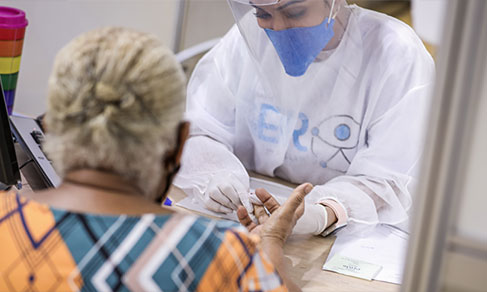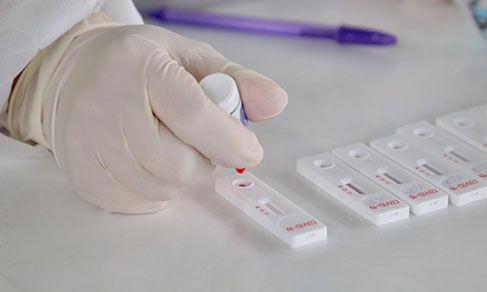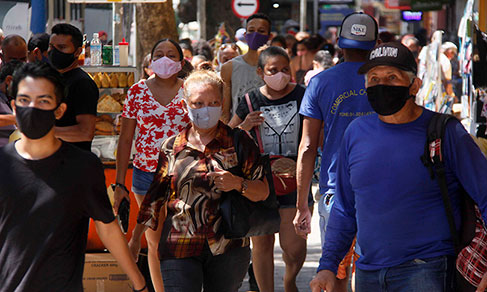Nossos serviços estão apresentando instabilidade no momento. Algumas informações podem não estar disponíveis.
 Experimental Statistics
Experimental Statistics
National Household Sample Survey - PNAD COVID19
Main results - November 2020
IBGE channel | COVID19
Access IBGE channel | COVID19 and take a look at infographs with highlighted information on the PNAD - COVID19.
Tables - November 2020
Results tables
- Health (in xlsx format)
- Labor (in xlsx format)
- Schools, loans and cleaning items (in xlsx format)
Concepts and methods - November 2020
As informações a seguir descrevem os metadados estatísticos, que são o conjunto de conceitos, métodos e aspectos relacionados às estatísticas, e são informações necessárias para compreender as características e a qualidade das estatísticas e interpretá-las corretamente.
Informações Gerais
Objetivo
Quantificar as pessoas com sintomas de Covid-19 e os impactos da pandemia no mercado de trabalho. A pesquisa tem ainda como objetivo atender demandas de alguns indicadores da Coordenação de Contas Nacionais para o cálculo do PIB Trimestral; da Coordenação de Índice de Preços para o cálculo da inflação; e da Coordenação de Trabalho e Rendimento para cálculo do RDPC para o FPE.Tipo de operação estatística
Outra pesquisa domiciliarTipo de dados
IndicadoresPeriodicidade de divulgação
MensalPopulação-alvo
Todos os moradores residentes nos domicílios selecionados para responder a pesquisaMetodologia
Para definir a amostra da nova pesquisa, o IBGE utilizou a base de 211 mil domicílios que participaram da PNAD Contínua no primeiro trimestre de 2019 e selecionou aqueles com número de telefone cadastrado.
A pesquisa vai estimar a quantidade de pessoas que tiveram algum dos sintomas de Covid-19, como febre, tosse, dificuldade de respirar, falta de paladar e olfato, fadiga, náusea e coriza.
Também será estimada a parcela da população que procurou atendimento e em quais tipos de estabelecimentos de saúde. Para os que não buscaram atendimento, será investigado as medidas que adotaram para tratar os sintomas.
Nos casos de internação, será possível saber também se o paciente foi sedado, entubado ou colocado em respiração artificial com ventilador. Já nas situações em que não houve deslocamento até uma unidade de saúde, será perguntado se os moradores receberam, por exemplo, a visita de um profissional de saúde na residência ou se tomaram algum remédio com ou sem orientação médica.
A PNAD Covid também vai acompanhar as mudanças no mercado de trabalho neste período de pandemia, abordando questões sobre a prática de home office, os motivos que impediram a busca por emprego e os rendimentos obtidos pelas famílias.
Técnica de coleta:
CATI - Entrevista por telefone assistida por computadorTemas
Temas e subtemas
Trabalho, População, SaúdePrincipais variáveis
Características dos moradores (idade, sexo, cor e escolaridade)Identificação de indivíduos com sintomas de síndrome gripal e COVID-19
Busca por estabelecimento de saúde de saúde pública
Tipo providência tomada para ser recuperar desses sintomas
Identificar o estabelecimento de saúde demandado em função dos sintomas
Identificar se houve internação na busca do estabelecimento de saúde
Procedimento adotado durante o processo de internação
Posse de plano de saúde
Características de trabalho das pessoas de 14 anos ou mais de idade
Rendimentos de outras fontes de todos os moradores do domicílio
Propriedade e valor do aluguel
Unidades de informação
Unidade de investigação
Pessoa, DomicílioUnidade de análise
PessoaUnidade informante
Pessoa.Períodos de referência
Data de início da coleta
01/11/2020Data do fim da coleta
30/11/2020Disseminação
Nível de desagregação geográfica
NacionalInstrumentos de coleta
Saiba mais
https://metadados.ibge.gov.br/consulta/estatisticos/operacoes-estatisticas/DPPublications - November 2020
Description
This survey aims at estimating the number of persons with symptoms associated with the flu syndrome and at following up the impact of the COVID-19 pandemic in the Brazilian labor market.
The data collection of the National Household Sample Survey - PNAD COVID19 began on May 4, 2020, with interviews by telephone in nearly 48 thousand households per week, adding up to nearly 193 thousand households per month in the entire National Territory. The sample is permanent, i.e., the households interviewed in the first month of data collection will remain in the sample along the next months, up to the end of the survey.
The questionnaire is divided into two parts, one directed to health issues, specifically on symptoms associated with the flu syndrome, and the other, to labor issues. The health issues investigate the occurrence of some of the major symptoms of COVID19 in the reference period of the survey, taking into account all the residents of the household. Those who showed any symptom are asked what were the actions taken for the relief of the symptoms; whether they sought any medical attendance due to these symptoms; and the type of health establishment sought. The labor issues aim at ranking the population at working age in the following categories: employed, unemployed and persons out of the workforce. The following aspects are also investigated: employment and activity; work leave and reason for leaving; home office; search for work; reason for not searching for work; weekly hours effectively and usually worked; as well as the effective and usual earnings from labor. Aiming at completing the household earnings, the residents are asked whether they received any earnings not coming from labor, such as: retirement, BPC-LOAS, Bolsa Família, any emergency aid related to COVID, unemployment insurance, rental and others. It should be highlighted that PNAD COVID19 is a survey with a dynamic data collection; therefore, the questionnaire is subject to changes along the application period.
The survey releases some indicators on a weekly basis, at Brazil level, and a wider set of indicators on a monthly basis, for Federation Units.
The pioneering results of PNAD COVID19 are the first release of Experimental Statistics produced by the IBGE, which are in line with the modernization strategy of the institution, thus allowing to improve the supply of information to meet the needs of the users.
Microdata
Microdata are the lowest level of data disaggregation in a survey, portraying, in the form of numeric codes, the content of the questionnaires, keeping data confidentiality. Microdata allow users specialized in programming languages or calculation software to create their own tables.
The present microdata files come together with documentation that provides the names and respective codes for variables and their categories.
Technical Information
News and Releases
Monthly Edition
PNAD COVID19: 22.7% of persons who tested for coronavirus until November were positive
Up to November, 28.6 million persons (13.5% of the population) had made some test to know whether they...
23/12/2020
Monthly Edition
28.6 million persons tested for Covid-19 until November
The number of persons who made some test to diagnose Covid-19 was 28.6 million until November. Of this...
23/12/2020
Monthly Edition
PNAD COVID19: by October, 22.4% of the persons tested for coronavirus were positive
By October, 25.7 million persons (12.1% of the population) had been tested to find out if they were infected...
01/12/2020
Monthly Edition
Number of people tested for Covid-19 rises to 25.7 million by October
The number of people who got tested for Covid-19 rose to 25.7 million in October. Of this total, about...
01/12/2020
Monthly Edition
PNAD COVID19: 22.1% of persons who were tested for coronavirus up to September were positive
Up to September, 21.9 million persons (10.4% of the population) had made any test to know whether they...
23/10/2020
Monthly Edition
10.4% of population were tested for Covid-19 until September in Brazil
The number of persons who were tested to diagnose Covid-19 reached 21.9 million in September, the equivalent...
23/10/2020
Weekly release
PNAD COVID19: 3.3% of employed population were away from work due to social distancing in fourth week of September
This proportion remained stable in the week of September 20-26 in relation to the previous week (3.4%)...
16/10/2020
Weekly release
Unemployment hits 14 million people in fourth week of September
According to PNAD COVID19, released today (16) by the IBGE, the number of unemployed persons hit 14 million...
16/10/2020
Weekly release
PNAD COVID19: 3.4% of the employed population were away from work due to social distancing in the third week of September
The week of September 13 to 19 was stable in relation to the previous week (3.7%) and well below the...
09/10/2020
Weekly release
Number of strictly isolated people in the pandemic drops to 33.8 million
The number of people under strict isolation to reduce the spread of the coronavirus fell by 1.6 million...
09/10/2020
Errata
Technical problem in one of the PNAD COVID19 microdata links
Published date: 23/10/2020
Description:
The PNAD COVID19 microdata files were made available as scheduled on the IBGE website, at 9 am on the correct date, in the Downloads tag of the survey page. However, due to a technical problem, the other link to these files was not available at the same time. It only became available on the survey page at 9:30 am.Actions: As soon as the problem was detected, the link to the microdata was made available on the survey page.
Error in the labor market indicators in the dissemination tables of PNAD-COVID19 (May 2020)
Published date: 02/07/2020
Description:
An error was identified in the dissemination of all the labor market indicators opened by professional activity. Due to a typing error, the figures related to the category of "Other services" were reported in the category of "Others", without any prejudice to the former.Actions: The file was amended with the correct figures and the category of "Others" was renamed as "Other activities". The file was replaced in the download area of the survey on the IBGE portal and in the News Agency.
Updating of the description of the following set of variables: B0011, B0012, B0013, B0014, B0015, B0016, B0017, B0018, B0019, B00110, B00111, B00112, V1012, V1016 in the microdata dictionary of PNAD-COVID19
Published date: 01/07/2020
Description:
1) Text change in vartiables B0011, B0012, B0013, B0014, B0015, B0016, B0017, B0018, B0019, B00110, B00111, B00112
From: In the last seven days
To: Last week2) Description change in variable V1012
From: 1 to 5
To: 1 to 43) Description change in variable V1016
From: 1 to 5 and “Interview number (1 to 5)”
To: 1 to 99 and “Interview number”Actions: The file was amended and replaced.

Estas estatísticas são classificadas como experimentais e devem ser usadas com cautela, pois são estatísticas novas que ainda estão em fase de teste e sob avaliação. Elas são desenvolvidas e publicadas visando envolver os usuários e partes interessadas para avaliação de sua relevância e qualidade. Caso deseje deixar uma crítica ou sugestão, clique aqui para deixar sua opinião.










